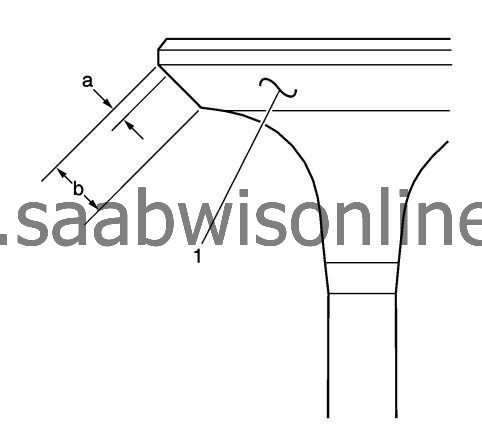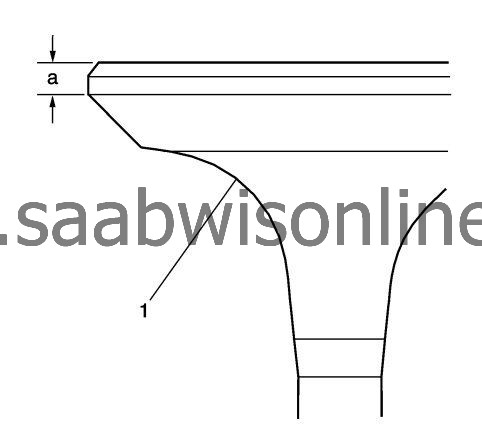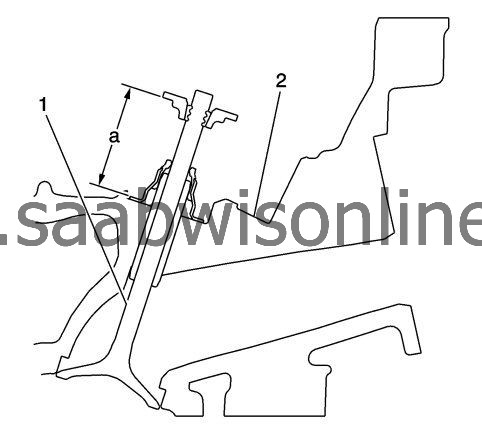Valve and Seat Grinding
| Valve and Seat Grinding |
| Valve Measurement and Reconditioning Overview |
| • |
Proper valve service is critical to engine performance. Therefore, all detailed measurement procedures must be followed to identify components that are out of specification.
|
|
| • |
If the measurement procedures reveal that the valve or valve seat must be reconditioned, it is critical to perform the measurement procedures after reconditioning.
|
|
| Valve Seat Width Measurement Procedure |
| 1. |
Measure the valve seat width in the cylinder head using a proper scale.

|
|
| 2. |
Measure the seat width (b) on the valve face (1) using a proper scale.

|
|
| 3. |
Compare your measurements with the specifications listed in Engine Mechanical Specifications (LDK, LHU) . |
|||||||
| 4. |
If the seat widths are acceptable, check the valve seat roundness using the Valve Seat Roundness Measurement Procedure.
|
|
| 5. |
If the seat width is not acceptable, you must grind the valve seat using the Valve and Seat Reconditioning Procedure to bring the width back into specification. Proper valve seat width is critical to providing the correct amount of valve heat dissipation.
|
|
| Valve Seat Roundness Measurement Procedure |
| 1. |
Measure the valve seat roundness using a dial indicator attached to a tapered pilot installed in the guide. The pilot should have a slight bind when installed in the guide.
|
|
| 2. |
Compare your measurements with the specifications listed in Engine Mechanical Specifications (LDK, LHU) . |
|||||||||
| 3. |
If the valve seat exceeds the roundness specification, you must grind the valve and valve seat using the Valve and Seat Reconditioning Procedure.
|
|
| 4. |
If new valves are being used, the valve seat roundness must be within 0.05 mm (0.002 in).
|
|
| Valve Head O.D. and Chamfer Measurement Procedure |
| 1. |
Measure the valve head O.D. and chamfer (a) using an appropriate scale. Refer to
Engine Mechanical Specifications (LDK, LHU)
.

|
|
| 2. |
If the valve head O.D. and chamfer is within specification, test the valve (1) for seat concentricity using the Valve-to-Seat Concentricity Measurement Procedure. Reinspect the valve head O.D. and chamfer after completing the concentricity measurement if valve seat reconditioning is performed.
|
|
| Valve-to-Seat Concentricity Measurement Procedure |
| 2. |
Install the valve in the cylinder head.
|
|
| 3. |
Turn the valve against the seat with enough pressure to wear off the dye.
|
|
| 4. |
Remove the valve from the cylinder head.
|
|
| 5. |
Inspect the valve face.
|
|
| • |
If the valve face is concentric, providing a proper seal, with the valve stem, a continuous mark (2) will be made around the entire face.
|
|||||||||||||
| • |
If the face is not concentric with the stem, the mark will NOT be continuous around the valve face. The valve should be refaced or replaced and the seat must be reconditioned using the Valve and Seat Reconditioning Procedure.
|
| Valve and Seat Reconditioning Procedure |
| 1. |
Grind the valve seating surface (a) to the proper angle specification (2) listed in Engine Mechanical Specifications (LDK, LHU) . 
|
||||||||||
| 2. |
Grind the valve relief surface to the proper angle specification (1) listed in
Engine Mechanical Specifications (LDK, LHU)
, to correctly position the valve seating surface (a) to the valve.
|
|
| 3. |
Grind the valve undercut surface to the proper angle specification (3) listed in
Engine Mechanical Specifications (LDK, LHU)
, to narrow the valve seating surface width (a) to the specifications listed in
Engine Mechanical Specifications (LDK, LHU)
.
|
|
| 4. |
Replace the intake valve if it is out of specification. Refer to Engine Mechanical Specifications (LDK, LHU) . |
|||||||
| 5. |
If the original exhaust valve is being used, grind the valve to the specifications listed in
Engine Mechanical Specifications (LDK, LHU)
. Measure the valve head O.D. and chamfer again after grinding using the Valve Head O.D. and Chamfer Measurement Procedure. Replace the exhaust valve if it is out of specification. New valves do not require grinding.
|
|
| 6. |
When grinding the valves and seats, grind off as little material as possible. Cutting valve seat results in lowering the valve spring pressure.
|
|
| 7. |
Install the valve in the cylinder head.
|
|
| • |
If you are using refaced exhaust valves, lap the valves into the seats with a fine grinding compound. The refacing and reseating operations should leave the refinished surfaces smooth and true so that minimal lapping is required. Excessive lapping will groove the valve face and prevent a good seat when hot.
|
| • |
Be sure to clean any remaining lapping compound from the valve and seat with solvent and compressed air prior to final assembly.
|
| 8. |
After obtaining the proper valve seat width in the cylinder head, you must re-measure the valve stem height using the Valve Stem Height Measurement Procedure.
|
|
| 9. |
If the valve stem height is acceptable, test the seats for concentricity using the Valve-to-Seat Concentricity Measurement Procedure.
|
|
| Valve Stem Height Measurement Procedure |
| 1. |
Install the valve (1) into the valve guide in the cylinder head (2). 
|
|||||||
| 2. |
Ensure the valve is seated to the cylinder head valve seat.
|
|
| 3. |
Install the valve stem oil seal.
|
|
| 4. |
Install the valve spring retainer and valve stem locks.
|
|
| 5. |
Measure the distance (a) between the valve seal lip to the bottom of the valve spring retainer. Refer to
Engine Mechanical Specifications (LDK, LHU)
.
|
|
| 6. |
If the maximum height specification is exceeded, a new valve should be installed and the valve stem height re-measured.
|
|
| 7. |
If the valve stem height still exceeds the maximum height specification, the cylinder head must be replaced. |
|||||||||||||||||

 Warning
Warning


